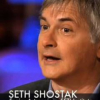Seth Shostak

Seth Shostak
Seth Shostakis an American astronomer, currently Senior Astronomer and Director, Center for SETI Research...
NationalityAmerican
ProfessionScientist
CountryUnited States of America
among developed few mold number proved science societies spread useful zero
Very few societies on Earth developed science as we know it today. On the other hand, the number is not zero - the Greeks, the Chinese, and the Maya did, among others. Once invented, science proved so useful that it spread like mold on a petri dish.
alexander based computer describe developed dutch entire hard ideas love mathematics opinion people personal scientist suggest talk using
Many people suggest using mathematics to talk to the aliens, and Dutch computer scientist Alexander Ollongren has developed an entire language (Lincos) based on this idea. But my personal opinion is that mathematics may be a hard way to describe ideas like love or democracy.
advance beings billions developing inevitably intelligence millions soon technology themselves unless wipe
Clearly, unless thinking beings inevitably wipe themselves out soon after developing technology, extraterrestrial intelligence could often be millions or billions of years in advance of us. We're the galaxy's noodling newbies.
artificial believe capability century computers develop double few handful hardly leave machines outrageous quickly scales time within
Our computers double in capability on time scales of only a few years. It's hardly outrageous to believe that we will successfully develop thinking machines within a handful of decades, or at most a century or two. If that happens, these artificial sentients will quickly leave us behind.
almost cocktail face people search somewhat work
Is E.T. out there? Well, I work at the SETI Institute. That's almost my name. SETI: Search for Extraterrestrial Intelligence. In other words, I look for aliens, and when I tell people that at a cocktail party, they usually look at me with a mildly incredulous look on their face. I try to keep my own face somewhat dispassionate.
bubble filled radio radius second served signals since television war
Ever since the Second World War, television signals (as well as FM radio and radar) have served as Homo sapiens' emissaries into deep space. High-frequency, high-power broadcasts have filled an Earth-centered bubble more than 60 light-years in radius with signals.
blades count lifestyle next obvious sets suggesting tv
Engineers are now experimenting with 4,096-line TV systems, suggesting that with the next generation of sets you'll be able to count the grass blades on the Superbowl field, an obvious lifestyle improvement.
came kid pick
'E.T.' was far-fetched. 'E.T.' was this wimpy-looking kid that came to Earth to pick some plants, but he came from the Andromeda Galaxy to do that.
endless universes
'Eternal inflation,' as it's called - the endless generation of new universes - may be a hyper-cosmic imperative. It seems that it must happen.
center centuries earth five news paid upset
Five centuries ago, Copernicus upset humanity's applecart with the news that the Earth is not the center of the cosmos. It could be that, before you've paid off your house, we'll learn that the universe is not the center of the universe, either!
open people promoted simply technology wide
The space elevator's not just another competitive technology, promoted by people who simply like the idea of diminishing the luster of the thrusters. It would open wide the doors to space.
bunch circle deduce earth fact invoking known phenomenon planet roughly taking thanks trace
Thanks to the fact that the Earth isn't a perfect sphere, and invoking a bunch of Newtonian physics, you can deduce that our planet wobbles, too, taking roughly 26,000 years to trace out a small circle on the sky, a phenomenon known as precession.
continue few hundred pump signals thousand washed
Television is ephemeral, a fact that some will find reassuring. But earthlings will continue to pump the kilowatts into the ether. And eventually, when those signals have washed over a few hundred thousand star systems, someone may notice.
amount anyone base beam billion consists few fit four genome human information microwave radio since travel types
Consider: The human genome consists of about 3.3 billion base pairs. Since there are only four types of pair, that amounts to 0.8 gigabytes of information, or about what you can fit on a CD. With a microwave radio transmitter, you could beam that amount of information into space in a few minutes, and have it travel to anyone at light speed.